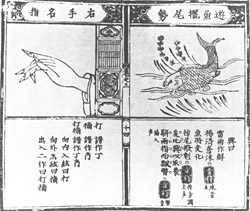| The upper illustration is from a Ming book on playing the guqin. The diagram in its upper left indicates the literal placement of the fingers on the strings. Beneath is a text describing the fingering. On the right the image bears the title: 'the propensity (勢 shi) of a swimming fish swishing its tail'. This provides a natural parallel to the quality sought in the musical performance. In pointing to this, we should imagine that this involves not only considering the fish but appreciating the resistance of the water and the reverberation of the fish's movement through it, and that this is a 'kind of motion' that would be encountered in other contexts. The sequence and quality of sounds is further discussed and compared to other natural conditions in the text appended to this. The lower illustration comes from a Ming discussion of calligraphy, the title page of a chapter concerning 'Seventy-two propensities (again, 勢 shi) of change in brush force.' In the upper segment, a brush dot is titled 'curious rock' and is encircled by words - many of them verbs describing the motion of a living creature: 'descends, climbs, walks, halts, piles up, becomes round, returns, hides.' In the lower segment, another calligraphic construction is described as a 'dragon claw' (while the words around it are in respect to the brush motion used to compose each part.) Employing parallels of this sort was an important dimension of instruction and reflection. It had the value of preceding from known and understood situations to those that were novel or challenging. It also drew upon and sustained an integration of cultural, natural and historical understanding, where linkages frequently related to shared propensities or 'a sense of life.' | | 
 |